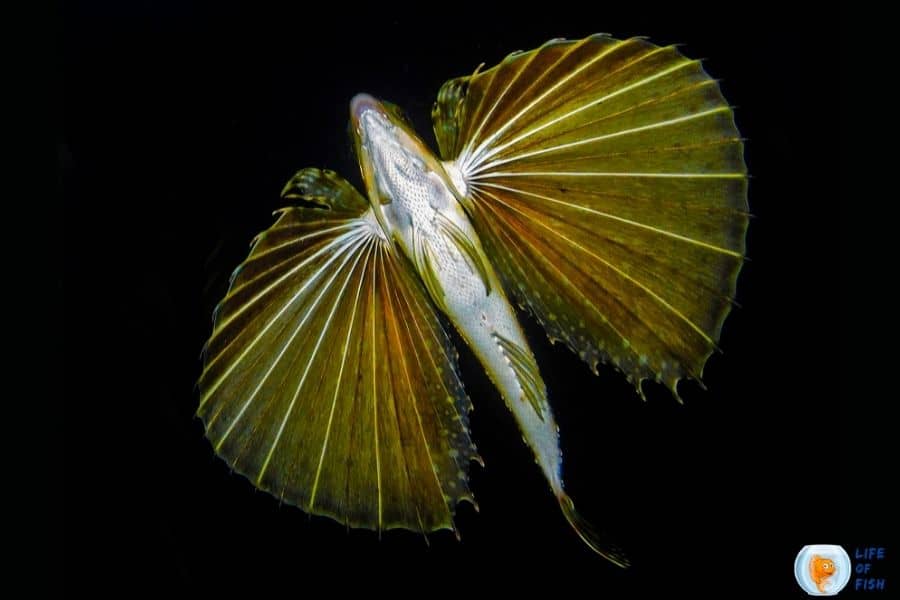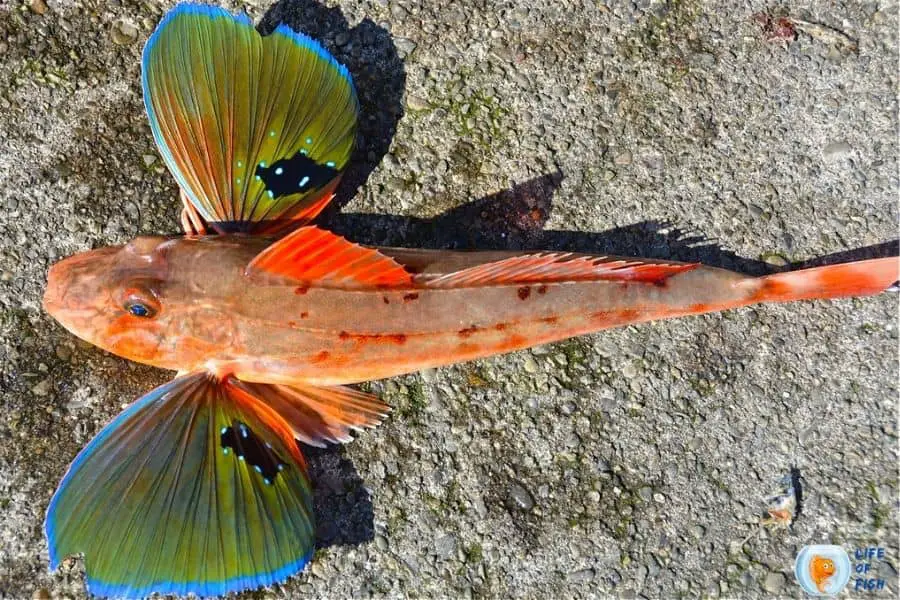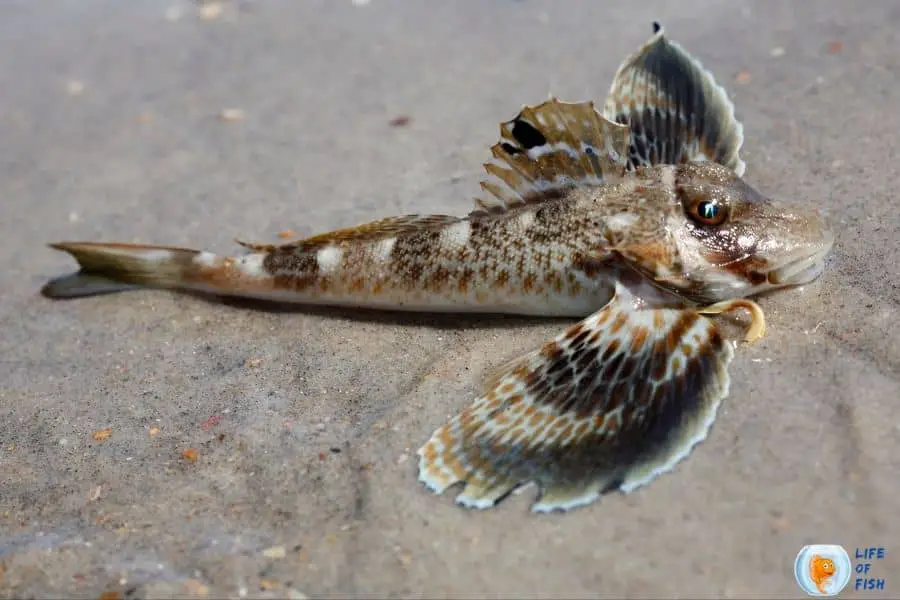If you see a colorful, flying bird, in the sea, don’t be amused! it is the Sea robin fish. They look like a single-engine Cessna’s wing, except underwater and on the bottom when their pectoral fins are fully extended.

How do You identify them?
Jump To
It has large pectoral fins and an elongated body. Most aquarists claimed that it is weird-looking fish due to its armored bony heads and large fan-shaped pectoral fins.
They are bottom dwellers and they are the owners of the largest pectoral fins of any bottom dweller in the Atlantic.
They are usually brightly colored, and some have ornately patterned pectoral fins.
Apart from their large pectoral fins, they have another unique feature, which is called “ walking rays”. They have three such features on each side of their body.
These walking rays have specialized muscle divisions and they are used as supportive structures during underwater locomotion.
The duty of walking rays is not confined to locomotion on the seafloor but to prey detection. They detect prey via chemoreceptors highly sensitive to the amino acids prevalent in some marine invertebrates.
These walking rays are adapted from fin rays, which act as supportive structures in the pectoral fins.
The fin rays separate from the rest of the pectoral fin and evolved as walking rays with unique anatomy during the development.
Actually, the term “Sea Robins “is used for a family, and there are a number of species of Sea robins.
They are also called gurnards and belong to the family Triglidae, order scorpaeniform.
This family contains nine different genera of bony fish found near the coast of the Atlantic, Pacific, and Indian oceans over a wide range of habitats.
The conservation status of sea robin fish according to the International Union for Conservation of Nature is at Least Concerned as these fish are spread all over the world in different geographical areas.
Where do they form?
Sea robin fish are found in warm and temperate seas throughout the world. They are particularly common in the Atlantic Ocean from Nova Scotia down to Florida.
They typically inhabit shallow coastal waters including estuaries. However, sometimes you can find them swimming freely in the open ocean or diving down to depths of more than 200 feet.
Sea robins like to live in open areas of the ocean floor. They favor sandy bottoms but can be found in bottoms covered with small rocks.
Are Sea robin fish aggressive?
There are many species of sea robins and most of the time they are peaceful. However, they can be aggressive in captivity depending on the species.
Sea robin fish behavior
They are bottom-dwelling fish and they live most of their time at the bottom of the ocean.
Sea robins are considered good swimmers as they can swim fast. They may swim at speeds close to 3.7 mph (6 kph) Unlike many other fish species, they can “walk” on the bottom of the ocean.
They use their pectoral fins to walk along the bottom of the ocean, looking for prey.
As described before, their fins are so sensitive and can feel things they encounter.
Even, they can move and manipulate small objects on the seafloor using their walking rays. They have bony heads and they use their heads as shovels to dig down and uncover small sea creatures to eat.
They head for the bottom and quickly burrow into the sand when threatened, leaving only their eyes and a few of their heads exposed.

How long do Sea robin fish live?
Actually, the lifespan of the Sea robin fish is still not discovered. However, according to the reports, the lifespan of Sea robin fish varies between 3-4 years.
One look Care guide
| Scientific name | Family Triglidae |
| Common name | Sea robin fish, Gurnads |
| Care level | Moderate |
| Native to | Warm and temperate seas including the Atlantic and Indian ocean |
| Type | Saltwater fish |
| Color | Varies with the species, Brightly colored fish |
| Tank size | 180 gal |
| Prefered temperature | 72-78° F |
| Other water parameters | pH 8.1- 8.4 Hardness dKH 8-12 Specific gravity 1.020 -1.025 |
| Preferred salinity | ~ 35 ppt |
| Growth rate | Moderate |
| Temperament | Peaceful |
| Recommended tank mates | Large, non-aggressive tank mates |
| Prefered food | Herrings Shrimp Seaweed Amphipoda Cumaean Gammarus Crabs Squid Segmented worms Bivalve mollusks Copepods Other fish & their eggs |
| Feeding frequency | Unknown |
| Breeding | Egg laying |
Sea robin fish care
Sea robin fish size
As described before, there are many species in the family of sea robins and their sizes depend on the species.
The length of most species is about 30 to 40 cm (12 to 16 inches). The length of the largest species of Sea robins is about 70 centimeters (28 inches).
Sea robin fish tank size
The tank size depends on which species of sea robin you intend to buy. The minimum tank size for the smallest species is 180 gallons.
How many Sea robin fish should be kept together?
Sea Robins generally get along together, so you can keep more than one in a tank.
Tank setup
They are really huge creatures compared to many other ornamental tank fish. Therefore, they need a big aquarium even if you want to keep one sea robin fish.
They prefer sandy bottoms, therefore the substrate should be sandy. They are bottom dwellers and most of the time they spend their time at the bottom of the tank.
Therefore, they don’t need a big vertical water column. Further, there should be minimum decorations at the bottom of the aquarium because the decorations limit the space.
They can move the small decorations and can dig and uproot the plants. If you need to keep plants in the aquarium secure them in a pot to avoid them being uprooted by the Sea robins.
Water quality condition
The water quality also changes a bit with the species of the sea robin. Especially, the water temperature varies with the species although all of them live in warm waters.
Generally, they need a water temperature of 72-78° F. The preferred pH level is 8.1-8.4. The hardness and the specific gravity of the water are dKH 8-12 and 1.020-1.025 respectively.

Sea robin fish breeding
The reproduction behavior varies depending on the species of the sea robins. However, generally, sea robin reaches reproductive maturity at age of two to three years.
Most the species of sea robins breed during the summer months. They need water at 71 degrees or higher temperature and usually, they breed during the months of July, August, and September.
During the mating season, sea robins produce a staccato call that is different than their usual grunting noise.
The color of their ovaries varies from yellow to orange color. The eggs in their ovaries are invisible to the naked eye.
The testes are clear white and long. When the ovaries are ripe, the eggs become visible to the eye.
The eggs are triangular in shape and you can see a few blood vessels on the surface of the eggs. The average egg size is 0.2 mm to 1.0mm.
The breeding season is prolonged because very few eggs are ripe at any one time. The female lays its eggs over a sandy area.
The fertilization of the eggs is external. Eggs are found in 22 C water and will hatch in 60 hours. The Sea robins do not care about their eggs or offspring.
Some species of sea robins lay eggs in estuaries and the inner shelf habitats while some species lay eggs in the deeper sea.
Special tips
Despite their unpleasant appearance Sea robins are a delicious meal among many communities.
They have a subtle flavor, similar to flounders, whitings, and flukes. They are popular when incorporated into soups and stews.
However, due to their bony fins and bony heads, it is difficult to clean them. Further, their eggs are sometimes used as a caviar substitute.
Sea robins are among few fish species that can generate sounds. They generate a croaking sound, much like a frog’s, using its swim bladder.
Many fishermen experienced their continuous croaking noise when they catch them. They also make staccato calls during mating season.
Sea-robin fish are considered trash fish and are often caught only by accident. They are good fighters. In some localities, Sea robins are classified in the sport fishery.
Although, Sea robins are fascinating fish to keep because of their uncommon appearance and bright colors, use caution when you are dealing with them.
Whether small or large, these creatures are extremely strong and can thrash around a lot. Their spins and hook-like spurs near the gills can cut or scrape a person causing injury.
Also, they can entangle in fishing nets causing you much trouble. According to reports, the dorsal fins, gill plates, and especially the sharp spins, carry very mild poison.
Feeding behavior of Sea robin fish
What do they eat ( in the wild and in an aquarium)
These marine animals are carnivores. In the wild, they eat anything which fits their mouths. Their main diet is herrings, shrimp, seaweed, Amphipoda, Cumaean, Gammarus, and crabs.
They also use squid, segmented worms, bivalve mollusks, copepods, other fish & their eggs as food.
Sea-robin fish are not picky feeders even when they are in captivity. They eat almost anything you feed.
However, the best food to feed them is small bottom-dwelling fish, black worms, shrimp (Mysis or brine), and other meaty foods.
You can train them to eat commercial foods too. Don’t keep small fish, crabs, or snails with them in the aquarium because they will be a delicious meal to the Sea robins.
How often should you feed, When should you feed (time of the day)
Sea-robin fish is still not a popular species in the aquaculture trade. This is because of the less understanding and the difficulty to accommodate large aquariums.
Therefore, the feeding behavior of sea robin fish in captivity is less understood.
Sea robin fish tank mates?
Sea robin fish are carnivores and eat anything that fits their mouth. Therefore, you cannot keep them with small fish.
Further, their mouths are big compared to their slender body and consider this tip also when you are picking tank mates for the Sea robin fish.
Apart from that, many species of sea robin fish are not aggressive and can co-exist with other tank mates.
However, make sure not to keep lots of bottom-dwellers with these creatures because they need huge space.
Read Next : What Do Saltwater Angelfish Eat? Mostly, Anything!
